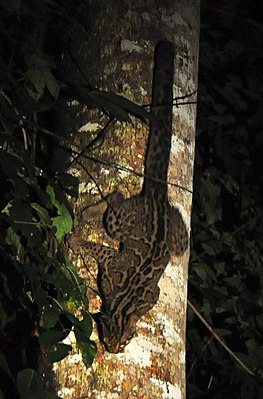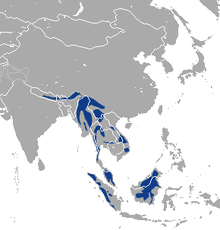Marble cat
| Marble cat | ||||||||||||
|---|---|---|---|---|---|---|---|---|---|---|---|---|

Marble cat ( Pardofelis marmorata ) |
||||||||||||
| Systematics | ||||||||||||
|
||||||||||||
| Scientific name of the genus | ||||||||||||
| Pardofelis | ||||||||||||
| Severzow , 1858 | ||||||||||||
| Scientific name of the species | ||||||||||||
| Pardofelis marmorata | ||||||||||||
| ( Martin , 1837) |
The marble cat ( Pardofelis marmorata ) is a small cat found in tropical regions of South and Southeast Asia . It has been on the IUCN's alert list since 2002 because the total population is likely to consist of fewer than 10,000 adult individuals and no population is greater than 1,000 adult marble cats.
Their fur pattern is astonishingly similar to that of the significantly larger clouded leopard .
features
Marble cats are a little larger than house cats : the head-torso length is about 45 to 62 centimeters, plus a 36 to 55 centimeter long, bushy tail. The body weight is around 2 to 5 kilograms.
The fur pattern of the marble cat is similar to that of the much larger clouded leopard : on a gray-brown to yellow-gray background, the fur has large, black, irregularly shaped spots, the inside of which is paler than the edges. There is therefore a possibility of confusion with clouded leopards that are not yet fully grown.
The shape of the marble cat is reminiscent of the Bengal cat widespread in the same area , although it is not directly related to it. The marble cat differs from the Bengal cat in that it has a shorter and wider skull. The marble cat often makes the typical “hump”, so that it can sometimes not be seen in any other position for a long time.
distribution and habitat
Marble cats are common on the mainland of Southeast Asia , from the Malay Peninsula to the foothills of the eastern Himalayas as well as on Sumatra and Borneo . They live primarily in evergreen tropical rainforests .
Way of life
Little is known about the way of life. As an apparently nocturnal loner, the marble cat probably hunts for squirrels , frogs , birds and insects . In marble cats that were observed in Nepal, the prey spectrum included hares , Turkish pigeons , rock pigeons , quail francolin , blue peafowl , calf pheasants , bankiva chickens and rats. A large part of the prey was felled on trees, but the marble cat also lurks on branches of ground-dwelling prey.
In contrast to the Bengal cat, which predominantly lives on the ground, the marble cat mostly seems to move in the branches of the trees - so Bengal and marble cats would hardly compete with each other. Only data from captivity are available on reproduction. Known litter sizes were two pups each. The gestation period is likely to be around 66–82 days.
Systematics and taxonomy
The first description of the marble cat was in 1837 by the British naturalist William Charles Linnaeus Martin under the name Felis marmorata . The terra typica of the species is the Indonesian island of Sumatra. In 1858, the Russian natural scientist Nikolai Alexejewitsch Severzow introduced the genus Pardofelis for the species. Shortly after the turn of the millennium, genetic analyzes showed that the Asian golden cat ( Catopuma temminckii ) and the Borneo golden cat ( Catopuma badia ) are closely related and, together with the marble cat, evolved separately from the other felids around 9.4 million years ago. All three species were therefore assigned to the genus Pardofelis . Only a few years later, differences were found in the anatomy of the skull between marble cats on the one hand and the Asian golden cats on the other. For this reason, and because of the different way of life of the three species, the Asian golden cats are predominantly terrestrial (ground-dwelling), the marble cats, however, largely tree-dwelling, the two golden cats were placed in the genus Catopuma introduced by Severzow in 1858 and the marble cat remains in Pardofelis alone .
Subspecies
British zoologist Reginald Innes Pocock published a new description of the marble cat in 1939 based on skulls and pelts taken from Java , Sumatra , Darjeeling and Sikkim . He classified the cat shape described by Gray as Felis charltoni in 1846 as a subspecies of Pardofelis marmorata . The nominal subspecies Pardofelis marmorata marmorata occurs in the east of the Himalayas , in Assam , Burma , on the Malay Peninsula , on the islands of Sumatra and Borneo and in Annam . Pardofelis marmorata charltoni lives in Nepal, Sikkim, Assam and northern Myanmar.
However, a phylogeographic study published in 2014 showed that five species of cats, including the marble cat, can be divided into an Indochinese and a Sunda clade, using the Isthmus of Kra on the Malay Peninsula as the border. In a revision of the cat system published in January 2017 by the Cat Specialist Group of the IUCN , the marble cat is therefore divided into the following two subspecies.
- Pardofelis marmorata marmorata ; Borneo, Sumatra and the Malay Peninsula south of the Isthmus of Kra (The population on Borneo has a more gray coat and may have to be classified as a further subspecies).
- Pardofelis marmorata longicaudata ; Nepal to Assam, Bangladesh, Southeast Asia north of the Kra isthmus (possibly a separate species)
natural reserve
Pardofelis marmorata is listed in Appendix I of the Washington Convention on Endangered Species . The hunt for marble cats is banned in Bangladesh , Cambodia , Yunnan , China , India , Indonesia , Malaysia , Myanmar , Nepal and Thailand .
Individual evidence
- ↑ a b c Hearn, A., Sanderson, J., Ross, J., Wilting, A., Sunarto, S., Ahmed Khan, J., Kukherjee, S., Grassman, L. (2008). "Pardofelis marmorata" . In: IUCN Red List of Threatened Species. Version 2010.4.
- ↑ Shrestha, p. 144
- ↑ Shrestha, p. 144
- ↑ Shrestha, p. 145
- ↑ a b Severtzow, MN (1858) Notice on the classification multisériale des Carnivores, spécialement des Félidés, et les études de zoologie générale qui s'y rattachent . Revue et Magasin de Zoologie Pure et Appliquée 2 e Série, T. X Séptembre 1858: 385-396
- ↑ Johnson, WE, Eizirik, E., Pecon-Slattery, J., Murphy, WJ, Antunes, A., Teeling, E., O'Brien, SJ (2006) The late miocene radiation of modern felidae: A genetic assessment . Science 311: 73-77. DOI: 10.1126 / science.1122277
- ↑ Fernando Lencastre Sicuro, Luis Flamarion B. Oliveira (2011): Skull morphology and functionality of extant Felidae (Mammalia: Carnivora): a phylogenetic and evolutionary perspective. Zoological Journal of the Linnean Society 161 (2): 414-462. DOI: 10.1111 / j.1096-3642.2010.00636.x
- ↑ a b M. E. Sunquist, FC Sunquist: Family Felidae (Cats) ; in: Don E. Wilson, Russell A. Mittermeier (Eds.): Handbook of the Mammals of the World , Volume 1: Carnivores ; Lynx Edicions, 2009; ISBN 978-84-96553-49-1 ; P. 141.
- ^ Pocock, RI (1939) The fauna of British India, including Ceylon and Burma. Mammalia. - Volume 1. Taylor and Francis, London. Pages 255-258
- ↑ Shu-Jin Luo, Yue Zhang, Warren E. Johnson, Lin Miao, Paolo Martelli, Agostinho Antunes, James ID Smith and others. Stephen J. O'Brien: Sympatric Asian felid phylogeography reveals a major Indochinese-Sundaic divergence. Molecular Ecology 23, 2072-2092. DOI: 10.1111 / mec.12716
- ↑ AC Kitchener, C. Breitenmoser-Würsten, E. Eizirik, A. Gentry, L. Werdelin, A. Wilting, N. Yamaguchi, AV Abramov, P. Christiansen, C. Driscoll, JW Duckworth, W. Johnson, S. -J. Luo, E. Meijaard, P. O'Donoghue, J. Sanderson, K. Seymour, M. Bruford, C. Groves, M. Hoffmann, K. Nowell, Z. Timmons, S. Tobe: A revised taxonomy of the Felidae . The final report of the Cat Classification Task Force of the IUCN / SSC Cat Specialist Group. In: Cat News. Special Issue 11, 2017, pp. 34–35.
literature
- Tej Kumar Shrestha: Wildlife of Nepal - A Study of Renewable Resources of Nepal Himalayas. Tribhuvan University, Kathmandu 2003, ISBN 99933-59-02-5
- Don E. Wilson, Russell A. Mittermeier (Eds.): Handbook of the Mammals of the World. Volume 1: Carnivores. Lynx Edicions, 2009, ISBN 978-84-96553-49-1 , (p. 161).
Web links
- Species profile marble cat; IUCN / SSC Cat Specialist Group in English
- Pardofelis marmorata in the endangered Red List species the IUCN 2006. Posted by: Cat Specialist Group, 2002. Retrieved on 11 May, 2006.

